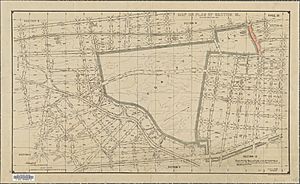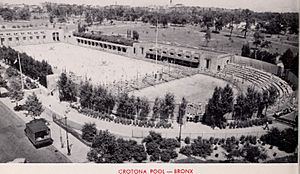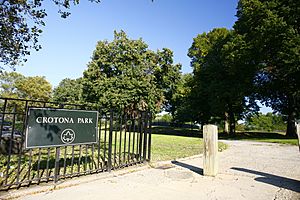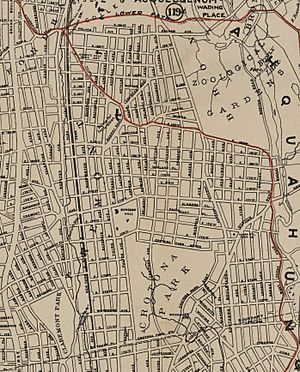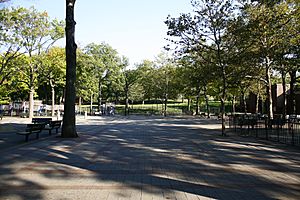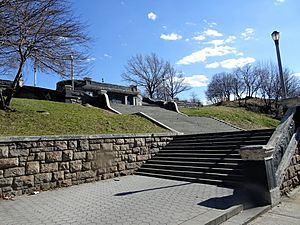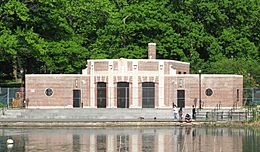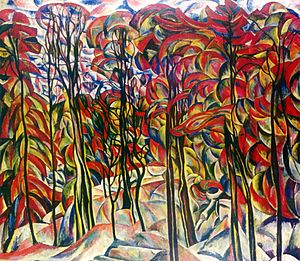Crotona Park facts for kids
Quick facts for kids Crotona Park |
|
|---|---|
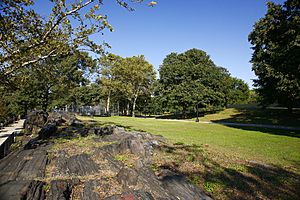 |
|
| Location | South Bronx, New York City, New York, U.S. |
| Area | 127.5 acres (51.6 ha) |
| Created | 1888 |
| Operated by | New York City Department of Parks and Recreation |
| Open | 7 a.m. to 10 p.m. |
| Status | open |
| Public transit access | New York City Subway: 174th Street ( New York City Bus: Bx11, Bx15, Bx17, Bx19, Bx21, Bx36 local buses |
Crotona Park is a large public park in the South Bronx, New York City. It covers about 127.5 acres (51.6 ha). The park is surrounded by streets that share its name. It sits next to the Crotona Park East and Morrisania neighborhoods. Two roads, Claremont Parkway and Crotona Avenue, divide the park into four parts.
This park used to be owned by the Bathgate family, who were important landowners in the South Bronx. It was created in 1888 as part of a plan to build many parks and parkways across the Bronx. The famous Crotona Play Center, with its swimming pool, was added in 1936. Crotona Park was once larger, but a part of it was separated by the Cross Bronx Expressway in 1945. That section is now called Walter Gladwin Park. After some tough times in the late 1900s, many projects began in the 1990s to make the park better.
Crotona Park has a 3.3-acre (1.3 ha) lake and many fun places to play, including a big swimming pool. The Crotona Play Center is a special building. It is recognized as a historic landmark by both national and city groups. The New York City Department of Parks and Recreation, also known as NYC Parks, manages the park.
Contents
Exploring Crotona Park's Past
How Crotona Park Began
In the 1870s, a landscape architect named Frederick Law Olmsted had an idea. He wanted to create a "greenbelt" of parks and parkways in the Bronx. This would follow the natural shape of the land. This was different from Manhattan's grid system, which led to Central Park with its mostly man-made features. However, the city did not use his plan at that time.
Around the same time, a newspaper editor named John Mullaly pushed for new parks in New York City. He started the New York Park Association in 1881. Some people worried the parks would be too far from Manhattan. They also thought the parks would stop new buildings from being built. But newspapers and important people supported the idea. They helped pass a law called the New Parks Act in 1884. This law allowed the city to create the park system.
Crotona Park was bought in 1888 because of this new law. It was part of the Bathgate family's land. Alexander Bathgate, who came from Scotland, bought the land from Gouverneur Morris. Back then, this area was called Bathgate Woods. It was a high spot with trees and a pond called Indian Lake. The Bathgate family let people use the area near Indian Lake for picnics.
In 1884, the Bronx Department of Parks said this land was perfect for a park. It had "luxuriant growth of forest" with oaks, elms, and magnolias. It was also close to train lines. Because the city was growing fast, Bathgate Farm became one of the few green spaces left. The park was first going to be called Bathgate Park. But because of disagreements, it was named "Crotona." This name came from an ancient Greek city in Italy. It also helped avoid confusion with the nearby Croton Aqueduct water system.
The park did not get many improvements until the 1900s. Indian Lake's edge was paved in the early 1900s. A place for ice-skaters and a warming hut were added. New landscaping was done, and a grandstand for concerts and games was built. In 1903, three hundred American elms were planted around the lake. Two years later, an athletic field was built for schools. Crotona Park grew with more land in 1907 and 1911. Extra tennis courts were added in 1915. A concrete wall around the lake, lamps, and paths were installed in 1914. A "farm garden" to teach children about farming was added in 1928.
By 1911, people living nearby complained about the noise from sports and concerts. They wanted the athletic field moved further into the park. In 1916, some landowners even sued. They said the field and bandstand were "nuisances" that made it hard to sell their homes.
Building New Facilities with the WPA
In 1934, Mayor Fiorello H. La Guardia chose Robert Moses to lead the New York City Department of Parks and Recreation. This was during the Great Depression, a time when many people were out of work. Moses quickly made a plan to create jobs through many projects.
Moses especially wanted to build new pools and bathing places. He made a list of 23 pools for the city, including one for Crotona Park. These pools would be built using money from the Works Progress Administration (WPA). The WPA was a government program created to help people find jobs during the Depression. Eleven of these pools were designed at the same time and opened in 1936.
Moses and architects Aymar Embury II and Gilmore David Clarke created a similar design for these pools. Each place would have separate pools for diving, swimming, and wading. They would also have seating areas and bathhouses with locker rooms. The pools had common features like a long length, underwater lights, and heating. They were built using simple, low-cost materials. The buildings mixed Streamline Moderne and Classical styles. They were also near playgrounds and improved landscapes.
Plans for ten tennis courts, a new playground, and more sports fields at Crotona Park were announced in May 1934. Construction for some of the 11 pools began that October. Crotona Park was the only place in the Bronx to get a WPA pool. A wading pool opened by mid-1935. The plans for the Crotona Park pool and bathhouse were approved in August. By mid-1936, ten of the eleven WPA pools were finished. The Crotona Pool opened on July 25, 1936, with a crowd of five thousand people. The main swimming pool was 330 by 125 feet (101 by 38 m). It also had a bathhouse and a wading pool.
In 1938, more improvements were planned for the parks with new pools. About $2.87 million was set aside for Crotona Park. This included fixing sidewalks on nearby streets. NYC Parks started rebuilding baseball and softball fields. In the 1940s, a brick boathouse was built by the lake. It replaced an old wooden one that had burned down. By 1941, these improvements were complete. Seven new playgrounds were added, and three others were rebuilt. A children's farm and two comfort stations were also built. Between 1934 and the 1960s, NYC Parks added the pool, bathhouse, five baseball fields, nine playgrounds, twenty tennis courts, and more.
Challenges and Comebacks
Crotona Park was once 155 acres (63 ha) big. In 1945, the Cross Bronx Expressway was built. This road cut off the northern part of Crotona Park. This northern section was called Crotona Park until 1987. Then it was renamed Highland Park, then Tremont Park in 1999, and finally Walter Gladwin Park in 2020.
By the 1950s, the park faced some safety challenges. To help, new lighting was installed in the park by 1963. Plans to fix up the Crotona Play Center were announced in 1965. However, these improvements did not happen. Many benches and water fountains were broken and not replaced. The boathouse stopped offering boat rides in 1970. In 1971, vandals stole parts from the play center, causing a lot of damage. To stop this, windows in the bathhouse were filled in. Still, the play center remained popular. In 1973, the city did a big cleanup of Crotona Park. This was to see if a full renovation was possible. Around this time, parts of the South Bronx faced many problems.
Park Improvements in the 1970s and 1980s
By the 1970s, Crotona Park and other city parks were in poor condition. This was after a financial crisis in New York City in 1975. NYC Parks planned to fix the pools in several parks in 1977, including Crotona Park. But these projects did not happen due to a lack of money. By 1981, NYC Parks had far fewer employees than before.
In 1982, the NYC Parks budget grew a lot. This allowed for many restoration projects. The Crotona Park pool was one of them. Work began in early 1983, and the pool complex was closed for two summers. The play center reopened on August 2, 1984.
Other parts of the park were also improved. The lake and boathouse were restored. Benches were replaced, and paths were repaved. In 1983, a volunteer ranger program started to help maintain parks. The nature rangers moved into the old boathouse in 1984. However, they left a few years later when their funding ran out.
Important people visited the park during this time. Three U.S. presidential candidates, Jimmy Carter, Ronald Reagan, and Bill Clinton, came to the park. Pope John Paul II even held a mass there in 1979. These visits helped show that Crotona Park was an important green space in the South Bronx.
Modern Day Restoration Efforts
NYC Parks continued to face money problems in the following years. The pools still had a reputation for safety issues. Crotona Park was also seen as an unsafe area. For example, in the summer of 1991, Mayor David Dinkins planned to close all 32 outdoor pools in the city. This decision was changed only after large donations were made. Also, in the 1990s, a problem called "whirlpooling" happened in city pools. This involved inappropriate touching of women by teenage boys. By the 2000s, crimes like this had decreased in parks because of better security.
By the 1990s, people wanted to make Crotona Park better. An organization called the Friends of Crotona Park was started in 1996. Two smaller pools next to the main pool were filled in. The diving pool was filled in by 1995. The rectangular wading pool was changed to a hexagon shape in the 1980s, then filled in by 1996. In 1999, a fund gave $1.1 million to restore five city parks, including Crotona Park. The city also added money to this project.
The park's nature center reopened in May 2001. A plan was made to restore and manage the park. This plan saw Crotona Park as a green space connecting the nearby communities. In 2009, the lake was restored, and a new outdoor stage was opened. A project to fix the nature center was approved in 2014. The Cary Leeds Center for Tennis & Learning opened near Indian Lake in 2015. It has a new two-story clubhouse and twenty fixed tennis courts.
NYC Parks also released a master plan for Crotona and Tremont Parks in June 2015. This plan suggested building a cafe, dog run, and skate park in Crotona Park. It also aimed to connect the parks better. The boathouse was restored in 2016. A renovation of the Crotona Play Area entrance was announced then. The lights on top of the main entrance towers were fixed in 2020. In 2021, NYC Parks suggested rebuilding the roof of the Crotona Park bathhouse.
Fun Things to Do and See
Crotona Park is bordered by Crotona Park West, Crotona Park North, Crotona Park East, and Crotona Park South. Claremont Parkway and Crotona Avenue divide it into four sections. The park serves many neighborhoods like Claremont, Belmont, Tremont, West Farms, Crotona Park East, and Morrisania. Because it's in the middle of these areas, Crotona Park is sometimes called the "Central Park of the South Bronx." The park also connects to Hylan Park and Walter Gladwin Park, though these connections could be better.
Crotona Park is home to 28 different kinds of trees. It also has the Crotona Pool, which is the biggest pool in the Bronx. Many asphalt paths cross the park, linking all its different features.
Sports and Play Areas
Playgrounds for Everyone
Crotona Park has twelve playgrounds for kids to enjoy:
- Bathgate Playground: Located at Fulton Avenue and 173rd Street. It is named after the Bathgate family.
- Boxcar Playground: Found at Crotona Park East and Charlotte Street.
- Carter Playground: Also at Crotona Park East and Charlotte Street. It was named for U.S. president Jimmy Carter in 1998.
- Clinton Playground: On Crotona Park South between Clinton and Prospect Avenues. It is named for governor DeWitt Clinton.
- Hill & Dale Playground: At Crotona Park East and 173rd Street.
- Martin Van Buren Playground: On Crotona Park East between Prospect Avenue and Claremont Parkway. It is named for U.S. president Martin Van Buren.
- Playground of the Stars: At Fulton Avenue between St. Pauls Place and 171st Street. It is named after four star groups carved near a fountain.
- Playground 1: At Crotona Park North and Crotona Avenue.
- Playground 3: At Crotona Park North between Marmion Avenue and Waterloo Place.
- Playground 4: At Crotona Park East between Waterloo Place and 173rd Street.
- Playground 11: At Fulton Avenue between Claremont Parkway and 172nd Street.
- Prospect Park: At Crotona Park North between Prospect and Marmion Avenues.
Fields and Courts for Sports
Crotona Park has many places for sports. Inside the recreation center, there is an indoor basketball court, a gym, and a community center. Outside, you can find many basketball courts, handball courts, soccer fields, and baseball fields.
Near the southern side of Crotona Park's pond, there is a baseball field, two basketball courts, and four handball courts. The northeast part of the park has two more basketball courts, eight handball courts, and a soccer field. On the northern side of the pond, there are two baseball fields and a basketball court. This area also has the Cary Leeds Center for Tennis and Learning, with twenty tennis courts. Across Claremont Avenue to the west is the Crotona Play Center. Here you'll find two baseball fields, a basketball court, and two handball courts. There's another basketball court at the northwest corner of Crotona Park South and Claremont Parkway. A baseball field is at the northeast corner of the same intersection.
In total, the park has six baseball fields, seven basketball courts, one soccer field, twenty tennis courts, and fourteen handball courts. The outdoor fields are free to use. Some indoor activities might need a membership.
Hylan Park
Hylan Park is a 15-acre (6.1 ha) sitting area at the northeast corner of Crotona Park. It is named after Mayor John Francis Hylan.
Walter Gladwin Park
Walter Gladwin Park is a 15-acre (6.1 ha) park just north of Crotona Park. The Cross Bronx Expressway separates the two parks. It is named after Walter Gladwin, who was the first Black person elected to a Bronx government office. This area has been called Tremont Park, Highland Park, and Old Borough Hall Park before. It was once part of Crotona Park. The park was renovated in 1995. It has basketball courts, a baseball field, playgrounds, showers, and chess tables. It was renamed for Gladwin in November 2020.
The park's most important features are the steps to the old Bronx Borough Hall site. The Borough Hall building was built in 1897. It was a fancy Italian-style building on a ridge in the park. The stone staircase was built two years later. When the Bronx County Courthouse was built in 1931, the borough offices moved. The old building was torn down in 1969.
Plans were developed to build a Walter Gladwin Recreation Center in the northern part of the park. Construction was planned to start in March 2025 and finish by 2027. It would include a media lab, a dance studio, fitness facilities, classrooms, and a gym. The gym would have courts for pickleball, volleyball, and basketball. This project is one of seven chosen to use environmentally friendly mass timber construction.
Natural Wonders
Crotona Park is on a high point in the Bronx. On clear days, you can see the Hudson River Palisades to the west. You can also see the Brooklyn Bridge to the south from some spots in the park.
Indian Lake and Nature Center
Crotona Park has a 3-acre (1.2 ha) pond called Indian Lake. The name supposedly comes from young people in the 1800s. They imagined Weckguasgeeck Indians sitting around the lake. The pond is also often called Crotona Lake. Historically, Indian Lake flowed into a brook that went south to the East River. An outdoor stage is at the southern edge of the lake. A stone bridge crosses an inlet at the very south end of the lake. The lake is home to ducks, turtles, and fish. The area around the lake has many native plants like tulip trees, black cherry, hickory, sassafras, and sweetgum. In 2015, the lake had too much algae and litter because it was near picnic areas.
Next to the lake's eastern side is a nature center. This brick building opened in 2001. It used to be a boathouse. The boathouse was built in the 1920s or 1940s, replacing an older wooden one. The nature center offers outdoor activities. These include nature walks, identifying plants and animals, and summer camps.
Crotona Play Center
|
Crotona Play Center
|
|
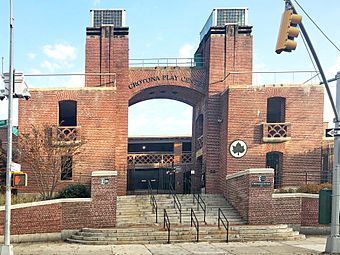
Crotona Play Center
|
|
| Location | 1700 Fulton Ave, Bronx, New York |
|---|---|
| Area | 9.32 acres (3.77 ha) |
| Built | 1934 – 1936 |
| Architect | Herbert D. Magoon; Aymar Embury II; Gilmore David Clarke |
| Architectural style | Art Moderne |
| NRHP reference No. | 15000177 |
| Significant dates | |
| Added to NRHP | April 28, 2015 |
The Crotona Play Center is in the northwest part of Crotona Park. It is the only swimming pool complex built by the Works Progress Administration in the Bronx. You can enter from Fulton Avenue and 173rd Street. This leads to the bathhouse and pool area. The play center covers 9.32 acres (3.77 ha). It has a bathhouse that separates the main pool from where a wading pool used to be. Inside the bathhouse, the locker rooms are mirror images of each other.
The complex was designed by Embury and Clarke with Herbert D. Magoon. Their design mixes Art Moderne and Modern Classical styles. The main buildings have sculptures by Frederick Roth. These include ibis-topped pillars on the bathhouse and carvings in the sitting areas by the pool.
On June 26, 2007, the New York City Landmarks Preservation Commission made the Crotona Play Center a city landmark. This means its inside and outside are protected. The play center was also added to the National Register of Historic Places on April 28, 2015.
The Bathhouse Building
The main entrance has a large arched brick gateway with towers. These towers have glass-block skylights and lanterns. Bronze letters above the arch spell "CROTONA PLAY CENTER." A stone at the base of the north tower says "A.D. 1936." A brick courtyard is at the top of the stairs. It is surrounded by a two-story building with a balcony. In the entrance area, there used to be booths that sold tickets for the bathhouse. These booths are now closed because the bathhouse is free to use. A walkway connects the courtyard building to a brick first-aid station.
East of the courtyard is a rectangular building with two similar sections. The northern section holds the men's locker room, and the southern section holds the women's locker room. The building has a brick front with decorative stone details. The western sides of both sections have arched window openings. The northern and southern sides each have seven sections with arched windows on the first floor. They also have skylights on the second floor. The eastern side of the building faces the pool area.
Inside, arched concrete supports hold up the roofs of each locker room. The bottom 6 feet 5 inches (1.96 m) of each wall are tiled, and the rest is plastered. Both locker rooms have lockers on their northern and southern walls. They are almost identical, except for where some windows are placed. From fall to spring, these locker rooms are used as gym facilities. East of the locker rooms are toilets and showers for each gender. The northern side of the bathhouse also has entrances to a girls' bathroom, a mothers' room, and an office. The southern side has a boys' bathroom.
The Swimming Pool Area
The complex has a rectangular main pool. It used to have smaller diving and wading pools too. The main pool is south of the bathhouse. It measures 330 by 125 feet (101 by 38 m) and is 4 feet (1.2 m) deep. South of the main pool was a semicircular diving pool. Since 2014, this area has spray fountains. A ramp provides an entrance to the pool from Fulton Avenue. Concrete bleachers are along the western side of the pool area. They are next to a wall that separates the pool from Fulton Avenue. The eastern side of the pool area has twelve sitting areas with benches. A single-story filter house is east of the main pool area.
The area where the wading pool used to be is now part of Bathgate Playground. It is north of the bathhouse and surrounded by a wall. The wading pool was once semicircular. It was changed to a hexagon shape in the 1980s, then filled in by 1996. This site now has playground equipment like swings and benches.
Special Events at the Park
From 1996 to 2012, Crotona Park hosted the EmblemHealth Bronx Open. This was an International Tennis Federation women's tennis tournament. It featured top players who used it to get ready for the US Open. The Bronx Open also hosted the United States Tennis Association's National Junior Doubles championship for young players. This event continued even after the ITF event ended. Money from the tournament helped New York Junior Tennis and Learning. The Bronx Open returned in 2019 as a WTA International tournament. It was held at the park and hosted by New York Junior Tennis and Learning.
On May 23, 2024, Donald Trump held a rally in Crotona Park for his 2024 U.S. presidential campaign.
More to Explore
- Art Deco architecture of New York City
- List of New York City Designated Landmarks in the Bronx
- National Register of Historic Places listings in the Bronx
See also
 In Spanish: Parque Crotona para niños
In Spanish: Parque Crotona para niños


